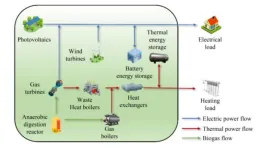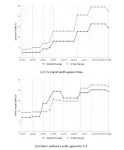(Press-News.org) Fifty years of change on iconic limestone pavements has revealed mixed fortunes for one of the most distinctive landscapes in the UK.
The landscapes - which will be familiar to visitors to the Yorkshire Dales and fans of Harry Potter and the Deathly Hallows film – have, in many places, seen reductions of specialist species and more common less desirable species become more abundant.
However, it is not all bad news as the picture is very mixed across the UK’s areas of limestone pavement with some areas increasing in plant biodiversity.
The findings, which reveal large changes since the 1970s, are from the first national assessment in half a century of plants and vegetation in Britain’s rare and iconic limestone pavements, which was conducted by Carly Stevens, Professor of Plant Ecology at Lancaster University.
An internationally important habitat, Britain’s limestone pavements are predominantly found in the northern English counties of Yorkshire, Lancashire and Cumbria, as well as in North Wales and Scotland.
Plants, such as ferns and herbaceous species more commonly found in woodland, heathlands and grasslands, grow within the deep gaps and cracks in limestone pavements known as grikes, often creating a hidden world that you cannot see until you stand directly above them.
In the early 1980s laws were introduced to protect limestone pavement from quarrying, and many areas are now covered by nature reserve status.
However, despite being a rare and treasured landscape feature, and habitat to many specialised plants and wildlife, Britain’s limestone pavements have undergone few scientific studies.
To help address this, Professor Stevens repeated a limestone pavement survey undertaken by two scientists (Stephen Ward and David Evans) in the early 1970s.
Professor Stevens used the same methods to replicate the 1970s study as best as possible, surveying areas of limestone pavement totalling 3157 hectares across five years between 2017 and 2022.
Her study, which is published in the academic journal Functional Ecology, recorded 313 plant species across UK limestone pavements – an additional 29 species on the number recorded in the 1970s.
And some pavements saw the number of plant species living there, or species richness, increase.
However, despite many areas falling under the protection of nature reserves, some less desirable species, such as thistles, nettles and bracken, have increased in abundance across different limestone pavements in the UK. And Professor Stevens also found that important specialist species, such as primrose, lily of the valley, elder flower trees and hairy violet, have declined in abundance across UK limestone pavements.
However, these declines were not uniform and some of these species did see increases in some areas – adding to a complex, but important picture that will be invaluable information for conservationists.
“Limestone pavements have undergone large changes in the number and types of plants that live in these rare and spectacular habitats,” said Professor Stevens. “Limestone pavements are a habitat of high conservation value and they are protected for their unusual geology and the plants and animals that live in them.
“But if we are to conserve them for future generations, it’s important to understand why these changes have occurred.”
A major factor appearing to affect some limestone pavements is tree cover. Professor Stevens undertook aerial photography comparisons with historical aerial images for all the limestone pavements in England to compare how the number and size of trees had changed.
She found that some pavements had seen their area shaded by trees increase by more than 50%. Despite this the number of pavements without trees also increased, showing there’s a very mixed picture across different areas – often depending on the number of trees in the surrounding area.
Pavements where the numbers of trees and shrubs increased have commonly seen reductions in plant biodiversity. Professor Stevens believes this is probably due to trees and shrubs blocking off the light for smaller plants in among the grikes. Those pavements most affected by tree cover are found in Lancashire and Cumbria.
Those pavements that have low or moderate tree cover are more likely to have seen increases in species richness – though not necessarily with desirable specialist species.
Professor Stevens found many open pavements were impacted by grazing of animals, though there have been changes in the 50 years between surveys.
“Grazing pressure has declined in a lot of areas since the 1970s as a result of agricultural policy but there are still some pavements that are overgrazed,” said Professor Stevens. “Grazing can be an important tool in the management of limestone habitats but it needs to be carefully considered as overgrazing can result in a loss of biodiversity. Similarly, under-grazing can result in scrub and tree encroachment, which we see can also affect diversity and species composition as light levels are reduced.”
The survey will help to inform the future management of limestone pavements, an area that is still developing and will benefit from the survey results and additional data.
“At this stage we don't actually know what optimal management looks like for limestone pavements,” said Professor Stevens. “This survey provides vital data to help further understanding on what the current picture is for limestone pavement vegetation. However, we still need more research to help improve our knowledge on what the threats are to habitat and the potential for restoring damaged limestone pavements.”
The study is outlined in the paper 'Large changes in vegetation composition seen over the last 50 years in British limestone pavements'.
ENDS
END
New study reveals half a century of change on Britain’s iconic limestone pavements
Fifty years of change on iconic limestone pavements has revealed mixed fortunes for one of the most distinctive landscapes in the UK
2024-11-14
ELSE PRESS RELEASES FROM THIS DATE:
Green flight paths could unlock sustainable aviation, new research suggests
2024-11-14
‘Green flight paths’ between key global locations could help to fast-track fully decarbonised aviation, according to research led by an international team based at Heriot-Watt University in the United Kingdom and the American University of Sharjah in the United Arab Emirates.
The research, published in the in the Royal Society of Chemistry’s top international journal, Energy and Environmental Science, recommends that a small number of long-haul flights with high passenger volumes, ...
Community partners key to success of vaccine clinic focused on neurodevelopmental conditions
2024-11-14
A new paper shows how partnering with the community can lead to more inclusive health care, especially for individuals with autism and other neurodevelopmental disabilities. The article, published this week in Pediatrics, details the success of a unique COVID-19 and flu vaccine clinic at the UC Davis MIND Institute.
The clinic team includes developmental-behavioral pediatricians, child life specialists, nurses, psychologists, social workers and staff trained to help families navigate health care. The goal is not only to administer vaccines, but to help patients build skills needed to successfully complete medical procedures for the rest of their lives.
Listening to ...
Low-carbon collaborative dual-layer optimization for energy station considering joint electricity and heat demand response
2024-11-14
In a significant step towards achieving the "Carbon Peaking and Carbon Neutrality" goals, researchers at the Chinese Academy of Sciences, University of Chinese Academy of Sciences, Beijing Institute of Technology, in collaboration with Hohai University, have developed a groundbreaking dual-layer optimization strategy for park-level integrated energy systems (PIES). This strategy, which integrates electricity and heat demand response, significantly boosts the economic efficiency and low-carbon operation ...
McMaster University researchers uncover potential treatment for rare genetic disorders
2024-11-14
Hamilton, ON, Nov. 14, 2024, In a groundbreaking study, researchers at McMaster University have identified a potential treatment for Sandhoff and Tay-Sachs diseases—two rare, often fatal lysosomal storage disorders that cause progressive damage to nerve cells in the brain and spinal cord.
After years of investigating the diseases’ underlying mechanisms, the research team has identified an existing FDA-approved drug that could significantly improve quality of life for affected patients and their families.
“Sandhoff and Tay-Sachs are devastating diseases,” ...
The return of protectionism: The impact of the Sino-US trade war
2024-11-14
Since 2018, Sino-US economic and trade relations have become increasingly tense. Between 2018 and 2019, the US imposed seven rounds of tariffs on China, to which China responded with retaliatory measures. The simple average tariff rates on US imports from China rose from 4.07% in January 2018 to 24.43% in December 2019, while the simple average tariff rates on Chinese imports from the US increased from 9.32% in January 2018 to 22.53% in December 2019 (see figure 1).
Consequently, the share of Chinese goods in US imports declined significantly — ...
UTokyo and NARO develop new vertical seed distribution trait for soybean breeding
2024-11-14
We have probably all seen a soybean plant, about 1 meter high with leaves and pods compactly arranged on a main stem with a few short side branches. The wild relative of the domesticated soybean is a long vine with pods widely distributed on many side branches. Plant breeding by farmers thousands of years ago is to thank for this dramatic change.
As human population increases and protein demand doubles, modern plant breeders must further optimize soybean plant architecture and per plant yield for modern farming systems. Conventional ...
Research into UK’s use of plastic packaging finds households ‘wishcycle’ rather than recycle – risking vast contamination
2024-11-14
Lancaster University researchers investigating consumer attitudes and behaviours around plastic food packaging have found UK households are ‘wishcycling’ rather than recycling – and say it’s a problem that everyone - government, food producers, waste management and residents – has to solve.
Wishcycling – the act of putting packaging in recycling bins and hoping for the best, rather than knowing it’s recyclable – is something households are doing due to confusing product labels and differing recycling facilities around the country, experts warn.
The academics behind Lancaster ...
Vaccine shows promise against aggressive breast cancer
2024-11-14
A small clinical trial shows promising results for patients with triple-negative breast cancer who received an investigational vaccine designed to prevent recurrence of tumors. Conducted at Washington University School of Medicine in St. Louis with a therapy designed by WashU Medicine researchers, the trial is the first to report results for this type of vaccine — known as a neoantigen DNA vaccine — for breast cancer patients.
The study, which found the vaccine to be well-tolerated and to stimulate ...
Adverse events affect over 1 in 3 surgery patients, US study finds
2024-11-14
Adverse events affect more than a third (38%) of adults undergoing surgery, finds a study of admissions to 11 hospitals in the US state of Massachusetts, published by The BMJ today.
Of the 1009 admissions analysed, nearly half were classified as major (resulting in serious, life threatening or fatal harm) and the majority were considered as potentially preventable.
Although this study may not fully represent hospitals at large, the findings show that “adverse events remain widespread in contemporary ...
Outsourcing adult social care has contributed to England’s care crisis, argue experts
2024-11-14
Outsourcing adult social care services in England to the private sector since the 1980s has led to worse care and should be rolled back, argue experts in The BMJ today.
Benjamin Goodair at the Blavatnik School of Government, University of Oxford and colleagues suggest that removing the profit motive would help improve quality and reduce inequities.
Social care, sometimes referred to as community, residential, or personalised care, for older people and people with physical and mental disabilities is facing record demand but performing worse than any time in recent history, they explain.
One contributor to this, they say, is the outsourcing of care provision from the ...
LAST 30 PRESS RELEASES:
Exposure to natural light improves metabolic health
As we age, immune cells protect the spinal cord
New expert guidance urges caution before surgery for patients with treatment-resistant constipation
Solar hydrogen can now be produced efficiently without the scarce metal platinum
Sleeping in on weekends may help boost teens’ mental health
Study: Teens use cellphones for an hour a day at school
After more than two years of war, Palestinian children are hungry, denied education and “like the living dead”
The untold story of life with Prader-Willi syndrome - according to the siblings who live it
How the parasite that ‘gave up sex’ found more hosts – and why its victory won’t last
When is it time to jump? The boiling frog problem of AI use in physics education
Twitter data reveals partisan divide in understanding why pollen season's getting worse
AI is quick but risky for updating old software
Revolutionizing biosecurity: new multi-omics framework to transform invasive species management
From ancient herb to modern medicine: new review unveils the multi-targeted healing potential of Borago officinalis
Building a global scientific community: Biological Diversity Journal announces dual recruitment of Editorial Board and Youth Editorial Board members
Microbes that break down antibiotics help protect ecosystems under drug pollution
Smart biochar that remembers pollutants offers a new way to clean water and recycle biomass
Rice genes matter more than domestication in shaping plant microbiomes
Ticking time bomb: Some farmers report as many as 70 tick encounters over a 6-month period
Turning garden and crop waste into plastics
Scientists discover ‘platypus galaxies’ in the early universe
Seeing thyroid cancer in a new light: when AI meets label-free imaging in the operating room
Neutrophil-to-lymphocyte ratio may aid risk stratification in depressive disorder
2026 Seismological Society of America Annual Meeting
AI-powered ECG analysis offers promising path for early detection of chronic obstructive pulmonary disease, says Mount Sinai researchers
GIMM uncovers flaws in lab-grown heart cells and paves the way for improved treatments
Cracking the evolutionary code of sleep
Medications could help the aging brain cope with surgery, memory impairment
Back pain linked to worse sleep years later in men over 65, according to study
CDC urges ‘shared decision-making’ on some childhood vaccines; many unclear about what that means
[Press-News.org] New study reveals half a century of change on Britain’s iconic limestone pavementsFifty years of change on iconic limestone pavements has revealed mixed fortunes for one of the most distinctive landscapes in the UK







